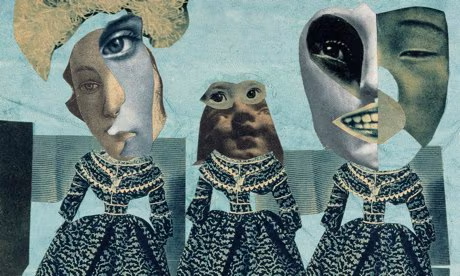Dual Metamorphosis
Wangechi Mutu: Forensic Forms, 2004,
ink, acrylic, collage, contact paper on Mylar.
Hannah and her scissors… Modenschau (Fashion Show), 1925-35 (detail) by Hannah Höch.
My project focuses more on interpersonal matters, as people, including myself, need to be better for their sake, others, and the world, if they genuinely choose to. Of course, everything is a massive shade of gray, as people change for better or worse. Someone who was once good but became a terrible person due to a specific trigger; a trigger can also make someone realize their mistakes and seek professional help. However, life can change people in many ways, especially others’ perceptions. Contemporary media plays a significant role in shaping identity, cultural, and societal norms. Through the images, messages, and stories conveyed in various forms of media, individuals are exposed to different ideas and perspectives that can influence their beliefs and values. For example, the representation of certain groups in media can impact the way people perceive them and the attitudes they hold towards them. Additionally, media can contribute to the creation of cultural norms by reinforcing certain behaviors and expectations through repeated exposure. According to Berger, “Compare the image of publicity and paintings in the book, or take a picture magazine, or walk down a smart shopping street looking at the window displays, and then turn over the pages of an illustrated museum catalogue, and notice how similarly messages are conveyed by the two media,” (Berger 138). At the same time, media can also challenge existing norms and promote social change by highlighting issues and presenting alternative viewpoints. Overall, the influence of contemporary media on identity, cultural, and societal norms is complex and multifaceted, but undoubtedly significant.
A lot of media I consume, whether social or mainstream media, does impact my life and who I am as a person, but not to a degree where I become delusional. Many people online, especially celebrities and influencers, use the media to inflate their egos, enabling their twisted desires to harm others intentionally. Whereas, other people use the media to not only better their own lives but others as well. However, most of the time, we may not know the difference until later on in the future. We essentially need to be better as people and exclude those who genuinely harm others, making for a better world not as consumed with our own hubris. Wangechi Mutu and Hannah Hoch address themes such as over-consumption, feminism, colonialism, violence, and political discourse. While expressing their creativity, they actively address prevalent topics in hopes of inspiring a better society. My project titled, “Dual Metamorphosis,” refers to my mental progress in life. Life can be beautiful, but not all the time, bad events like getting into a bad argument with a loved one, and just what feels like never-ending stress. All sources of trauma will send me deep into my mind, forgetting the real world so that I can heal. According to Sontag, “In deciding how a picture should look, in preferring one exposure to another, photographers are always imposing standards on their subjects. Although there is a sense in which the camera does indeed capture reality, not just interpret it, photographs are as much an interpretation of the world as paintings and drawings are,” (Sontag). I control everything in my mind, shutting out the real world, forgetting every flaw I have, everything that I can do to stay in my escapism mentality. However, that escapism does harm my real-world responsibilities and my future. Therefore, I take steps to get better mentally and physically, acknowledging that life is complicated and I need to make the best out of my only life.
The artists that inspired my project are Wangechi Mutu and Chris LeBeau, adopting both of their bizarrely anatomical pieces. The design of my portrait reflects the progression of my mental health, from maladaptive daydreaming (left) to getting better for my future (right). The left embodies my creative yet chaotic mentality, due to stress from everyday life, causing my body to look less like me; whereas my right, shows me breaking out of bad habits and improving my lifestyle. According to Mirzoeff, “Ignoring the spectacle of Earth, space, and moon, Hoshide turned the camera on himself, creating the ultimate selfie, or self-taken self-portrait,” (Mirzoeff x). The left highlighted in red and purple, has a rigid and menacing exterior, conveying that I am always protective of myself. As for the wings, they symbolize my mind always being above the clouds, avoiding my responsibilities. As for the right in green, it embodies a plant-like exterior, save for my natural face. The plants around my body symbolize my growth as a person, becoming better and more grounded in reality. The assets I used in my portrait were strictly from stock images and video game textures. Fashion is professionally subjective, as I mainly wanted to convey my mental health journey. Yet, through the artists chosen as my inspiration, Wangechi Mutu and Hannah Hoch, I took note of their portraits’ anatomical modifications and applied that to my own. Half of my adulthood is molded through the media I consume, while my childhood was brought up by my parents. I am aware of the world’s problems as well as my own, yet I help others whenever I can, given my current capabilities. I only ever help others if I know what I am getting into. Since this is the only life I have, I need to live it as best as I can, helping when I can, all without causing any major problems for myself or others. This mentality is something others should live by.
.png)


No comments:
Post a Comment